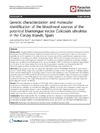Please use this identifier to cite or link to this item:
https://accedacris.ulpgc.es/jspui/handle/10553/7941
| Title: | Genetic characterization and molecular identification of the bloodmeal sources of the potential bluetongue vector Culicoides obsoletus in the Canary Islands, Spain | Authors: | Martínez-de la Puente, Josué Martínez, Javier Ferraguti, Martina Morales-de la Nuez, Antonio Castro, Noemí Figuerola, Jordi |
Keywords: | Bluetongue virus Bloodmeal Culicoides Goats Schmallenberg virus, et al |
Issue Date: | 2012 | Journal: | Parasites and Vectors | Abstract: | Background: Culicoides (Diptera: Ceratopogonidae) biting midges are vectors for a diversity of pathogens including bluetongue virus (BTV) that generate important economic losses. BTV has expanded its range in recent decades, probably due to the expansion of its main vector and the presence of other autochthonous competent vectors. Although the Canary Islands are still free of bluetongue disease (BTD), Spain and Europe have had to face up to a spread of bluetongue with disastrous consequences. Therefore, it is essential to identify the distribution of biting midges and understand their feeding patterns in areas susceptible to BTD. To that end, we captured biting midges on two farms in the Canary Islands (i) to identify the midge species in question and characterize their COI barcoding region and (ii) to ascertain the source of their bloodmeals using molecular tools.Methods: Biting midges were captured using CDC traps baited with a 4-W blacklight (UV) bulb on Gran Canaria and on Tenerife. Biting midges were quantified and identified according to their wing patterns. A 688 bp segment of the mitochondrial COI gene of 20 biting midges (11 from Gran Canaria and 9 from Tenerife) were PCR amplified using the primers LCO1490 and HCO2198. Moreover, after selected all available females showing any rest of blood in their abdomen, a nested-PCR approach was used to amplify a fragment of the COI gene from vertebrate DNA contained in bloodmeals. The origin of bloodmeals was identified by comparison with the nucleotide-nucleotide basic alignment search tool (BLAST). Results: The morphological identification of 491 female biting midges revealed the presence of a single morphospecies belonging to the Obsoletus group. When sequencing the barcoding region of the 20 females used to check genetic variability, we identified two haplotypes differing in a single base. Comparison analysis using the nucleotide-nucleotide basic alignment search tool (BLAST) showed that both haplotypes belong to Culicoides obsoletus, a potential BTV vector. As well, using molecular tools we identified the feeding sources of 136 biting midges and were able to confirm that C. obsoletus females feed on goats and sheep on both islands.Conclusions: These results confirm that the feeding pattern of C. obsoletus is a potentially important factor in BTV transmission to susceptible hosts in case of introduction into the archipelago. Consequently, in the Canary Islands it is essential to maintain vigilance of Culicoides-transmitted viruses such as BTV and the novel Schmallenberg virus. | URI: | https://accedacris.ulpgc.es/handle/10553/7941 | ISSN: | 1756-3305 | Other Identifiers: | http://dx.doi.org/10.1186/1756-3305-5-147 | DOI: | 10.1186/1756-3305-5-147 | Source: | Parasites and Vectors,v. 5 (147) |
| Appears in Collections: | Artículos |
SCOPUSTM
Citations
31
checked on Jun 8, 2025
WEB OF SCIENCETM
Citations
26
checked on Jun 8, 2025
Page view(s)
94
checked on May 4, 2024
Download(s)
99
checked on May 4, 2024
Google ScholarTM
Check
Altmetric
Share
Export metadata
Items in accedaCRIS are protected by copyright, with all rights reserved, unless otherwise indicated.
